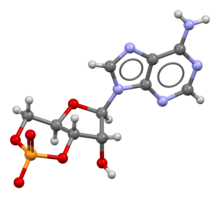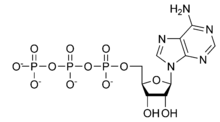Cyclic adenosine monophosphate(cAMP,cyclic AMP,or3',5'-cyclicadenosine monophosphate) is asecond messenger,or cellular signal occurring within cells, that is important in many biological processes. cAMP is a derivative ofadenosine triphosphate(ATP) and used for intracellularsignal transductionin many different organisms, conveying thecAMP-dependent pathway.

| |

| |
| Names | |
|---|---|
| IUPAC name
Adenosine 3′,5′-(hydrogen phosphate)
| |
| Systematic IUPAC name
(4aR,6R,7R,7aS)-6-(6-Amino-9H-purin-9-yl)-2,7-dihydroxytetrahydro-2H,4H-2λ5-furo[3,2-d][1,3,2]dioxaphosphinin-2-one | |
| Identifiers | |
3D model (JSmol)
|
|
| ChEBI | |
| ChEMBL | |
| ChemSpider | |
| DrugBank | |
| ECHA InfoCard | 100.000.448 |
| KEGG | |
| MeSH | Cyclic+AMP |
PubChemCID
|
|
| UNII | |
CompTox Dashboard(EPA)
|
|
| |
| |
| Properties | |
| C10H11N5O6P | |
| Molar mass | 329.206 g/mol |
Except where otherwise noted, data are given for materials in theirstandard state(at 25 °C [77 °F], 100 kPa).
| |


History
editEarl SutherlandofVanderbilt Universitywon aNobel Prize in Physiology or Medicinein 1971 "for his discoveries concerning the mechanisms of the action of hormones", especially epinephrine, viasecond messengers(such as cyclic adenosine monophosphate, cyclic AMP).
Synthesis
editThe synthesis of cAMP is stimulated by trophic hormones that bind to receptors on cell surface. cAMP levels reach maximal levels within minutes and decrease gradually over an hour in cultured cells.[1] CyclicAMPis synthesized fromATPbyadenylate cyclaselocated on the inner side of the plasma membrane and anchored at various locations in the interior of the cell.[2]Adenylate cyclase isactivatedby a range of signaling molecules through the activation of adenylate cyclase stimulatory G (Gs)-protein-coupled receptors. Adenylate cyclase isinhibitedby agonists of adenylate cyclase inhibitory G (Gi)-protein-coupled receptors. Liver adenylate cyclase responds more strongly to glucagon, and muscle adenylate cyclase responds more strongly to adrenaline.
cAMP decomposition intoAMPis catalyzed by the enzymephosphodiesterase.
Functions
editcAMP is asecond messenger,used for intracellular signal transduction, such astransferringinto cells the effects ofhormoneslikeglucagonandadrenaline,which cannot pass through the plasma membrane. It is also involved in the activation ofprotein kinases.In addition, cAMPbinds toand regulates the function ofion channelssuch as theHCN channelsand a few othercyclic nucleotide-binding proteinssuch asEpac1andRAPGEF2.
Role in eukaryotic cells
editcAMP is associated with kinases function in several biochemical processes, including the regulation ofglycogen,sugar,andlipidmetabolism.[3]
In eukaryotes, cyclic AMP works by activating protein kinase A (PKA, orcAMP-dependent protein kinase). PKA is normally inactive as a tetramericholoenzyme,consisting of twocatalyticand two regulatory units (C2R2), with the regulatory units blocking the catalytic centers of the catalytic units.
Cyclic AMP binds to specific locations on the regulatory units of the protein kinase, and causes dissociation between the regulatory and catalytic subunits, thus enabling those catalytic units tophosphorylatesubstrate proteins.
The active subunits catalyze the transfer of phosphate from ATP to specificserineorthreonineresidues of protein substrates. The phosphorylated proteins may act directly on the cell's ion channels, or may become activated or inhibited enzymes. Protein kinase A can also phosphorylate specific proteins that bind to promoter regions of DNA, causing increases in transcription. Not all protein kinases respond to cAMP. Several classes ofprotein kinases,including protein kinase C, are not cAMP-dependent.
Further effects mainly depend oncAMP-dependent protein kinase,which vary based on the type of cell.
Still, there are some minor PKA-independent functions of cAMP, e.g., activation ofcalcium channels,providing a minor pathway by whichgrowth hormone-releasing hormonecauses a release ofgrowth hormone.
However, the view that the majority of the effects of cAMP are controlled by PKA is an outdated one. In 1998 a family of cAMP-sensitive proteins withguanine nucleotide exchange factor(GEF) activity was discovered. These are termed Exchange proteins activated by cAMP (Epac) and the family comprisesEpac1andEpac2.[4]The mechanism of activation is similar to that of PKA: the GEF domain is usually masked by the N-terminal region containing the cAMP binding domain. When cAMP binds, the domain dissociates and exposes the now-active GEF domain, allowing Epac to activate small Ras-like GTPase proteins, such asRap1.
Additional role of secreted cAMP in social amoebae
editIn the speciesDictyostelium discoideum,cAMP acts outside the cell as a secreted signal. Thechemotacticaggregation of cells is organized by periodic waves of cAMP that propagate between cells over distances as large as several centimetres. The waves are the result of a regulated production and secretion of extracellular cAMP and a spontaneous biological oscillator that initiates the waves at centers of territories.[5]
Role in bacteria
editInbacteria,the level of cAMP varies depending on the medium used for growth. In particular, cAMP is low when glucose is the carbon source. This occurs through inhibition of the cAMP-producing enzyme,adenylate cyclase,as a side-effect of glucose transport into the cell. The transcription factorcAMP receptor protein(CRP) also calledCAP (catabolite gene activator protein)forms a complex with cAMP and thereby is activated to bind to DNA. CRP-cAMP increases expression of a large number of genes, including some encodingenzymesthat can supply energy independent of glucose.
cAMP, for example, is involved in the positive regulation of thelac operon.In an environment with a low glucose concentration, cAMP accumulates and binds to the allosteric site on CRP (cAMP receptor protein), a transcription activator protein. The protein assumes its active shape and binds to a specific site upstream of the lac promoter, making it easier for RNA polymerase to bind to the adjacent promoter to start transcription of the lac operon, increasing the rate of lac operon transcription. With a high glucose concentration, the cAMP concentration decreases, and the CRP disengages from the lac operon.
Pathology
editSince cyclic AMP is a second messenger and plays vital role in cell signalling, it has been implicated in various disorders but not restricted to the roles given below:
Role in human carcinoma
editSome research has suggested that a deregulation of cAMP pathways and an aberrant activation of cAMP-controlled genes is linked to the growth of some cancers.[6][7][8]
Role in prefrontal cortex disorders
editRecent research suggests that cAMP affects the function of higher-order thinking in theprefrontal cortexthrough its regulation of ion channels calledhyperpolarization-activated cyclic nucleotide-gated channels(HCN). When cAMP stimulates the HCN, the channels open, This research, especially the cognitive deficits in age-related illnesses and ADHD, is of interest to researchers studying the brain.[9]
cAMP is involved in activation of trigeminocervical system leading to neurogenic inflammation and causing migraine.[10]
Role in infectious disease agents' pathogenesis
editDisrupted functioning of cAMP has been noted as one of the mechanisms of several bacterial exotoxins.
They can be subgrouped into two distinct categories:[11]
- Toxins that interfere with enzymesADP-ribosyl-transferases,and
- invasive adenylate cyclases.
ADP-ribosyl-transferases related toxins
edit- Cholera toxinis anAB toxinthat has five B subunints and one A subunit. The toxin acts by the following mechanism: First, the B subunit ring of the cholera toxin binds toGM1gangliosideson the surface of target cells. If a cell lacks GM1 the toxin most likely binds to other types of glycans, such as Lewis Y and Lewis X, attached to proteins instead of lipids.[12][13][14][11]
Uses
editForskolinis commonly used as a tool in biochemistry to raise levels of cAMP in the study and research ofcellphysiology.[15]
See also
edit- Cyclic guanosine monophosphate(cGMP)
- 8-Bromoadenosine 3',5'-cyclic monophosphate(8-Br-cAMP)
- Acrasinspecific to chemotactic use inDictyostelium discoideum.
- phosphodiesterase 4(PDE 4) which degrades cAMP
References
edit- ^Hanukoglu I, Feuchtwanger R, Hanukoglu A (November 1990). "Mechanism of corticotropin and cAMP induction of mitochondrial cytochrome P450 system enzymes in adrenal cortex cells".J Biol Chem.265(33): 20602–8.doi:10.1016/S0021-9258(17)30545-8.PMID2173715.
- ^Rahman N, Buck J, Levin LR (November 2013)."pH sensing via bicarbonate-regulated" soluble "adenylate cyclase (sAC)".Front Physiol.4:343.doi:10.3389/fphys.2013.00343.PMC3838963.PMID24324443.
- ^Ali ES, Hua J, Wilson CH, Tallis GA, Zhou FH, Rychkov GY, Barritt GJ (2016)."The glucagon-like peptide-1 analogue exendin-4 reverses impaired intracellular Ca2+ signalling in steatotic hepatocytes".Biochimica et Biophysica Acta (BBA) - Molecular Cell Research.1863(9): 2135–46.doi:10.1016/j.bbamcr.2016.05.006.PMID27178543.
- ^Bos, Johannes L. (December 2006). "Epac proteins: multi-purpose cAMP targets".Trends in Biochemical Sciences.31(12): 680–686.doi:10.1016/j.tibs.2006.10.002.PMID17084085.
- ^Anderson, Peter A. V. (2013-11-11).Evolution of the First Nervous Systems.Springer Science & Business Media.ISBN978-1-4899-0921-3.
- ^Abramovitch, Rinat; Tavor, Einat; Jacob-Hirsch, Jasmine; Zeira, Evelyne; Amariglio, Ninette; Pappo, Orit; Rechavi, Gideon; Galun, Eithan; Honigman, Alik (15 February 2004)."American Association for Cancer Research (cAMP-responsive Genes and Tumor Progression)".Cancer Research.64(4): 1338–1346.doi:10.1158/0008-5472.CAN-03-2089.PMID14973073.S2CID14047485.
- ^Dumaz, Nicolas; Hayward, Robert; Martin, Jan; Ogilvie, Lesley; Hedley, Douglas; Curtin, John A.; Bastian, Boris C.; Springer, Caroline; Marais, Richard (October 2006)."American Association for Cancer Research (cAMP Dysregulation and Melonoma)".Cancer Research.66(19): 9483–9491.doi:10.1158/0008-5472.CAN-05-4227.PMID17018604.
- ^Simpson, B. J.; Ramage, A. D.; Hulme, M. J.; Burns, D. J.; Katsaros, D.; Langdon, S. P.; Miller, W. R. (January 1996)."American Association for Cancer Research (cAMP-binding Proteins' Presence in Tumors)".Clinical Cancer Research.2(1): 201–206.
- ^"ScienceDaily::Brain Networks Strengthened By Closing Ion Channels, Research Could Lead To ADHD Treatment".
- ^Segatto, Marco (2021)."Neurogenic Inflammation: The Participant in Migraine and Recent Advancements in Translational Research".Biomedicines.10(1): 76.doi:10.3390/biomedicines10010076.PMC8773152.PMID35052756.
- ^abKather, H; Aktories, K (November 15, 1983)."cAMP-System und bakterielle Toxine [The cAMP system and bacterial toxins]".Klin Wochenschr.61(22): 1109–1114.doi:10.1007/BF01530837.PMID6317939.S2CID33162709.RetrievedFebruary 26,2022.
- ^Amberlyn M Wands; Akiko Fujita (October 2015)."Fucosylation and protein glycosylation create functional receptors for cholera toxin".eLife.Vol. 4.doi:10.7554/eLife.09545.
- ^Cervin J, Wands AM, Casselbrant A, Wu H, Krishnamurthy S, Cvjetkovic A, et al. (2018) GM1 ganglioside-independent intoxication by Cholera toxin. PLoS Pathog 14(2): e1006862.https://doi.org/10.1371/journal.ppat.1006862
- ^Fucosylated Molecules Competitively Interfere with Cholera Toxin Binding to Host Cells; Amberlyn M. Wands, Jakob Cervin, He Huang, Ye Zhang, Gyusaang Youn, Chad A. Brautigam, Maria Matson Dzebo, Per Björklund, Ville Wallenius, Danielle K. Bright, Clay S. Bennett, Pernilla Wittung-Stafshede, Nicole S. Sampson, Ulf Yrlid, and Jennifer J. Kohler; ACS Infectious Diseases Article ASAP, DOI: 10.1021/acsinfecdis.7b00085
- ^ Alasbahi, RH; Melzig, MF (January 2012). "Forskolin and derivatives as tools for studying the role of cAMP".Die Pharmazie.67(1): 5–13.PMID22393824.